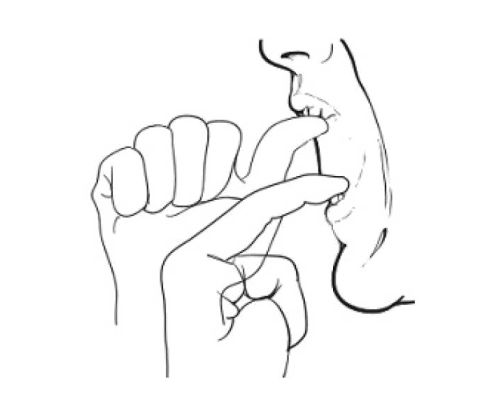Vocal Warm Up Exercises
Procedures
Vocal warm up exercises
The following exercises are designed to relax your head and neck and warm up your voice. A careful warm-up routine is a good way to start the day of voice use and strengthen your vocal cords. If possible, complete these exercises one or two times daily (in the morning and the afternoon or evening).
STEP 1. STRETCHING
- Stretch your upper body (or, if you have time, the whole body). Reach up with your arms; try to bring your elbows together in the back. Shake your hands down by your side.
- Roll your shoulders. Begin first with the left shoulder. Roll it eight to 10 times. Allow the rotations to become larger as it is comfortable to do so. Repeat with the right shoulder. Make the movements slow and easy.
- Roll your neck with eight to 10 rotations to the right and left. Make these motions slow and sweeping. Start with your chin straight down against your sternum. Think about your chin as a pendulum. Roll your chin over to the right shoulder. Hold this position for a slow count to five. Move your chin back to the middle. Repeat on the left side. Each time you roll, stop in the middle. Hold these positions for a slow count of five. When you do this activity, let your mouth open slightly.
- Try some easy, exaggerated chewing, like you have a few pieces of bubble gum in your mouth. If necessary, use your hands to massage your cheeks. Chew for two to three minutes without making a sound, then hum while you are chewing. Let your voice come out easily and softly.
- Use your hands to massage your neck and throat in a firm downwards direction.
- The Yawn-Sigh: Begin by attempting the most authentic yawn you can imagine. Lift your chin slightly; open the mouth wide so that you feel a stretch in the jaw. Feel your voice box in your throat with your flat hand on your neck. It should go down when you yawn. Pull your tongue back along the floor of the mouth, and breathe in deeply. As you exhale, sigh ‘ah’ and hold it out for three to five seconds. The voice quality should be soft and cottony as it comes from deep in your throat. Don’t allow the voice to turn off mid-way through your sigh. The exercise is in the soft cottony sigh. You should feel really open in your throat. Repeat these yawn-sighs eight to 10 times slowly with attention to the quality of the voice, the accuracy of your form, and the feeling of openness you get.
STEP 2. VOCAL WARM-UP / STRENGTHENING
- The Fog Horn: Begin with a deep lower abdominal breath. Purse your lips into a narrow ‘O’ shape. Make an ‘oo’ vowel sound (like ‘oops’) on a low comfortable note and hold for six to eight seconds. Your voice quality should be very quiet and breathy. Relax the cheeks and allow the breath to puff them out. There should be some airflow through your lips (like you would do to make a candle light flicker). If you are doing this exercise correctly, you will feel a vibration in your lips or nose. If you don’t feel this, try using a lower pitch and more air. Repeat 10 times.
- The Lip or Tongue Trill: This exercise is similar to the fog horn above. Begin by taking a deep lower abdominal breath. Bring the lips together and jut them out slightly. Make sure your lips and cheeks are relaxed. Begin breathing out as you produce the sound “Brrrr.” The lips should trill consistently. If they stop moving or stop trilling, take another breath and begin again. If you have trouble trilling with your lips, try your tongue. Once you are able to do this with ease, experiment with pitch sweeping from low to high pitch and then high to low pitch. Repeat 10 times.
- The Pitch Slide: Your goal is to slide softly from your lowest pitch to your highest pitch as you say the word “Whoop.” Make sure the sound is soft, with lots of breath support and with an extra ‘puh’ sound at the end of the word. Imagine saying “Whoop-puh.” Repeat eight to 10 times, then reverse and slide your pitch from high to low. This time, say the word “boom.” Repeat eight to 10 times. In both cases, focus on the sound and vibration at your lips. The goal is to perform the slides without voice breaks.
- The Hum: Produce a gentle “hummmm” at a low but comfortable pitch. Repeat and change the “hmm” to “ahhh” halfway through the breath. Try to change nothing else but opening your mouth as you move from one sound to the next. Experiment with pitch sweeping from low to high pitch and then high to low pitch. Repeat 10 times.
- Articulation flexibility: Repeat “Mumula Mumula Mumula Mumula Mumula Mumula Mumula Mumula”. Focus on clear articulation. Keep the air flowing easily; experiment with changing the pitch higher or lower as you repeat the exercise.
If you have any questions, contact:
Anna Miles – Speech-language Therapist
Auckland ENT Group
242 Great South Rd Greenlane
T 09 5222226
F 09 5222224
E info@aucklandent.co.nz

Massage, stretching and exercise is the key to reduce fluid build-up (lymphoedema). Jaw opening is critical and jaw stretching should be completed daily.

Auckland ENT will be in touch to arrange regular appointments to ensure you are well supported and informed. Please contact us if you have any questions or new concerns.

